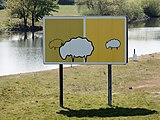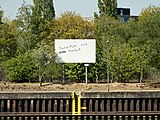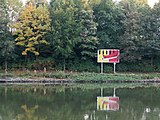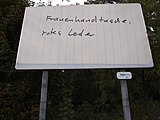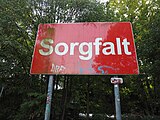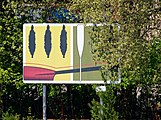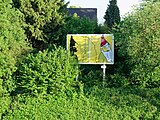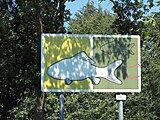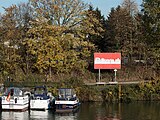KulturKanal
KulturKanal is a cultural project that was introduced as part of the European Capital of Culture RUHR.2010 . The geographic focus of the project is the area around the Rhine-Herne Canal , which was formerly characterized by coal transport . With Herne as the initiator and project sponsor city, all ten neighboring cities along the waterway came together for the first time to promote art and culture and initiate infrastructural improvements.
The catchment area of the KulturKanal runs through the Ruhr Metropolis, right through the Emscher Landscape Park . It extends from the inner harbor of Duisburg over the Rhine , the port canal, the Rhine-Herne canal and the Dortmund-Ems canal to the Dattelner Meer . According to the RUHR.2010, the KulturKanal is one of the most sustainable Capital of Culture projects. The city of Herne has meanwhile taken part in the "Erlebnis.NRW" competition as the project sponsoring city . As part of the contribution "Rhine-Herne Canal: Place of Culture and the Lock to the Emscher Landscape Park", the jury recommended the project for funding from the NRW Ministry of Economics.
Since 2012, the KulturKanal has been funded under the leadership of the Ruhr Regional Association (RVR) as part of the Erlebnis.NRW funding program. By 2015, RVR and neighboring municipalities, together with the partners Wasser- und Schifffahrtsamt Duisburg-Meiderich (WSA), ADFC-NRW, Emschergenossenschaft and Ruhr Tourismus GmbH, will sharpen the tourist profile of the KulturKanal.
Artistic concept
The organizers wanted to conquer the channel for people, culture and leisure. The project was particularly dedicated to upgrading the quality of use and the quality of stay in public space along the waterway in long-term cooperation - initially through interventions in the field of culture and art. This happened in the course of the program over a distance of around 70 kilometers and included the Ruhr area cities of Duisburg , Oberhausen , Essen , Bottrop , Gelsenkirchen , Herne , Recklinghausen , Castrop-Rauxel , Waltrop and Datteln . For the duration of the project, with monthly priorities and in connection with other cultural capital projects on the Emscher Island, they became targeted cultural venues. The focus of the project was on both the diverse possibilities of sailing on the water and the experience on the water.
Measures by 2010
New permanent passenger ship piers (e.g. at the Künstlerzeche Unser Fritz 2/3 , Herne) have been built and new ones will follow. B. in Castrop-Rauxel on the Wartburginsel, in Gelsenkirchen-Bismarck and in Bottrop-Ebel . There was an intensification of passenger shipping through regular shuttle boats. A bicycle culture guide was specially created for the network of cycle paths along the banks.
The map set presents the sights on the KulturKanal in the Emscher Landscape Park . For the first time, it shows the cycle paths on the north and south banks that can be used continuously.
Central program items
1 - "Channel annealing: Non Stop City"
Under the program item “Canal Glow: Non Stop City”, nightly light rides took place between April and June. In the work NON STOP CITY, designed by Erik Göngrich and raumlaborberlin, a “hyperreal and utopian image of the city at the same time” was created using projections and drawings. This was expressed in the form of images and texts intended to make invisible information about the canal landscape visible during the several-hour journeys, as well as light projections and acoustic signals that transform the landscape.
2 - pictures on the canal
Since June 2010, an artistic guidance system in the form of a 25-year open-air exhibition has been accessible to visitors from Duisburg to Datteln along the canal. Consisting of large, sculptural tableaus at 15 bank locations, it is intended to serve as a permanent “connecting and obvious element with a signal character in the Emscher Landscape Park”. Various aspects such as people, landscape and architecture of the region are artistically represented on the 5.95 × 3.4 m large tableaus themselves.
This was preceded by a competition in early December 2009 with the call to design images for an artistic guidance system on the KulturKanal. 135 artists from North Rhine-Westphalia applied and submitted over 800 designs. The jury selected five graphic works each by the artists Bernd Zamel (Hagen) and Markus Hanakam (Essen) as well as the artist duo Petra Weifenbach and Axel Siefer (Cologne). The artists' works can be found at the following locations:
- 1/15 Bernd Zamel / Duisburg (confluence of the Rhine-Herne Canal / Ruhr)
- 2/15 Markus Hanakam / Duisburg (Neumühl harbor)
- 3/15 Petra Weifenbach and Axel Siefer / Oberhausen ( Oberhausen lock )
- 4/15 Markus Hanakam / Oberhausen (east of Konrad-Adenauer-Brücke)
- 5/15 Bernd Zamel / Oberhausen (city triangle Oberhausen-Essen-Bottrop)
- 6/15 Markus Hanakam / Bottrop (Berne culvert)
- 7/15 Petra Weifenbach and Axel Siefer / Essen (Zweigert Bridge)
- 8/15 Markus Hanakam / Gelsenkirchen ( Nordsternpark )
- 9/15 Petra Weifenbach and Axel Siefer / Gelsenkirchen (Graf Bismarck district)
- 10/15 Markus Hanakam / Herne (Resser Forest)
- 11/15 Bernd Zamel / Herne ( Wanne-Eickel lock )
- 12/15 Bernd Zamel / Herne ( Recklinghausen city port )
- 13/15 Petra Weifenbach and Axel Siefer / Castrop-Rauxel (Bladenhorster Bridge)
- 14/15 Bernd Zamel / Castrop-Rauxel (Wartburg Island)
- 15/15 Petra Weifenbach and Axel Siefer / Waltrop ( old ship lift Henrichenburg )
photos
3 - choir channel
Another main item on the program in the context of the KulturKanals was the Capital of Culture project "! SING - DAY OF SONG", which was carried out on June 5, 2010. Together with choirs on the banks of the Rhine-Herne Canal, "three ship parades with singing crew" - flanked by sports boats - sounded a "Choir Canal". 11 ships were in use, including a. a Viking boat, a historic diesel launch, a coal-fired steam tug, a boat of the Navy Fellowship and many passenger ships.
What was special about the Choir Canal were the many choir locations on the Canal. Some of the choirs could get out here and sing along on site or sing along to the shore from the boat. The visitors also heard the singing in the locks. In the late afternoon the choir ships reached the pier in Gelsenkirchen and went from there to the Veltins-Arena to sing along to the big final concert.
In 2012 (June 2nd) and 2014 (September 27th) the project! SING - DAY OF SONG was continued. Cultural and public places on the KulturKanal were again transformed into choir venues, historical ships, culture ships and passenger ships with choirs and music on board also sailed across the channel again.
4-channel drive
The long-term goal of all municipalities bordering the Rhine-Herne Canal is to develop the waterway's infrastructure and develop it into a cultural and tourist axis. The culture ship "Friedrich der Große", based in Herne, was able to offer for the first time in 2008 as a bo (o) tschafter in the service of the Capital of Culture movement, for example, water excursions with cabaret, comedy, live music, literature, poetry and drama. All other passenger ship operators were also on the move as culture ships. The offer should continue to exist. A new resting place for water hikers in the Recklinghausen city harbor has been created for pleasure boat tourists . New jetties for public passenger shipping ensure a seamless connection between the cities.
5 - FilmSchauPlätze 2010
In summer, open-air cinema took place at special locations on the canal, right by the water and in the open air. The venues along the Rhine-Herne Canal marked as FilmSchauPlätze included the Niederrhein Stadium , the newly designed outdoor area of the artists mine Unser Fritz 2/3 Herne, the Recklinghausen city harbor , the Wartburg Island and the Datteln harbor. The FilmSchauPlatz series was organized and carried out by the Filmstiftung NRW and local partners.
Since then, there have also been FilmSchauPlätze on the KulturKanal, including in 2012 at the Herner Künstlerzeche Unser Fritz 2/3 and the Bootshaus Bottrop, and in 2014 at the Dattelner Hafen and in BernePark Bottrop.
6 - channel rest
In 2010 five artistically designed picnic areas, designed by the Herne artist Beate Matkey, were set up. Their distinguishing feature is a permanently installed parasol and a picnic blanket design based on the respective location. The picnic areas serve permanently as meeting points for cultures in the Emschertal and are 15 m² in size. You can find them in the following places:
- in the Gelsenkirchener Nordsternpark (the "Emscherbruch - 4 season cover"),
- in Recklinghausen / Castrop-Rauxel Pöppinghausen (the "musical island cover"),
- in Gelsenkirchen Veltins-Arena near Sutumer Brücke ("the ball sports ceiling"),
- at the Gelsenkirchen bridge at the ZOOM adventure world (the "Nasobemdecke"), as well as
- the “Kirmissage ceiling” in the cultural park Unser Fritz 2/3, Herne next to the pier
Other new resting places are the Ebel balcony and the Neanderthal resting place in Bottrop or the newly designed bridge bank in the Graf Bismarck district.
7 - extra shift / night of industrial culture
Since 2008, culture ships have been commuting between the ExtraSchicht venues on the canal, between Oberhausen Castle , Nordsternpark Gelsenkirchen , the Recklinghausen substation (with the Museum of Electricity and Life) at the Recklinghausen city harbor and the area of the Unser Fritz 2/3 artists' mine in Herne.
8 - children on the canal
From July 15 to August 1, 2010, a series of workshops entitled “Water connects” enabled children from districts in Oberhausen, Bottrop, Gelsenkirchen, Recklinghausen and Herne, through which the KulturKanal flows, to experience their living space anew. In camps along the waterway, they were able to rediscover their urban environment in a playful and artistic way. In addition to a joint boat trip and a final party in the Nordsternpark, workshops were offered that ranged from the construction of imaginative floating objects to open-air painting and an art tour by Münster art students with the children.
The “Children on the Canal” project was consolidated in the years that followed and was carried out annually with alternating participation of the neighboring municipalities, since 2014 as part of the NRW culture backpack. In 2014 workshops and activities took place in Gelsenkirchen, Recklinghausen and Herne with a closing party at the Museum Strom und Leben and joint shipping.
9 - culture ships
On culture ships, guests with music, theater, comedy, literature and film were transported via the KulturKanal. Cinema ships showed the film culture from the Ruhr area. There was a children's cinema ship for children. The OLGAS ROCK open-air festival in August 2010 began with a boat trip for musicians and fans to the festival site.
Since then, culture ships for various cultural sectors have been offered annually on the KulturKanal. In particular, intercultural issues are in the foreground.
10 - Other attractions: opening and closing party
A water show and music in the newly designed Recklinghausen city harbor marked the start of this series of events on March 20, 2010. Ten cities sent their “ambassadors” to the opening event in Recklinghausen under the motto “TEN DRIVE WITH”.
The final week began on September 26, 2010 together with the light art project "Ruhrlights: Twilight Zone" in Duisburg's inner harbor with walk-in light architectures and multimedia performances. The closing ceremony also offered a concert with a small ensemble of the Duisburg Philharmonic on the water. Then a DJ set by Sebastian Maier aka Sola Plexus started in the light architecture of Modulorbeat. Here specially composed sounds from the KulturKanal region could be heard. The KulturKanal also presented itself with a retrospective of film and photo material in the stairwell tower in the " Garden of Remembrance ."
At the end of the KulturKanal 2010, the Herne sound artist Christof Schläger transformed originally technical signal transmitters from ships into futuristic sound objects and united them into an orchestra with his project SCHWINGUNGEN on the premises of the STEAG power plant. Due to the enormous volume of the ship horns used, a half-hour musical game with the structure of the landscape was created. The sound horns were accompanied by a “ballet of concrete pumps” in a choreographed sequence of movements.
Measures after 2010
The KulturKanal has been stabilized since 2012 under the leadership of the Regionalverband Ruhr (RVR) as part of the Erlebnis.NRW funding program and expanded into a sustainable adventure and tourist passage. The tourism valuation is based on various measures.
In 2014, as part of a new edition of the KulturKanal bike guide, a continuously navigable, 86-kilometer main route directly on the canal bank was developed from the north and south routes. The route is based on approved cycle paths on the bank and mostly leads along the service routes of the Duisburg-Meiderich waterways and shipping office directly along the water.
The website of the project was further developed, revised and designed as a tourist website. The central element of the new Kulturkanal.ruhr online presence is an interactive map with GPS track that provides all information on sights, works of art, leisure options, events, restaurants and accommodation providers. All locations are presented with text and images and marked directly on the map for orientation. An event calendar provides information on tours, programs and offers along the KulturKanals.
Anniversary 100 years of the Rhine-Herne Canal
In 2014 the Rhine-Herne Canal , the heart of the KulturKanal, turned 100 years old. To mark the anniversary, the KulturKanal network organized a year-round festival program. Over 120,000 visitors accepted the invitation and celebrated the canal at over 200 events on and on the water.
Ship parade KulturKanal
The anniversary year and the passenger ship season on the KulturKanal began with an artistically staged parade of ships from Gelsenkirchen to Oberhausen , in which around 20 passenger ships, WSA work ships, historic ships and motor sports boats took part.
Day of action KanalLeben
On August 30, 2014, the KulturKanal network celebrated the anniversary of the Rhine-Herne Canal together with all partners with an intermunicipal canal life event . On that day, the canal was closed to motorized shipping from the Duisburg-Meiderich lock to the old Henrichenburg ship lift in Waltrop . Water sports clubs along the canal, in cooperation with the KulturKanal network, put together an interactive program with games, sports, picnics, hands-on activities, live music, theater and cabaret.
Outdoor exhibition "time window"
An outdoor exhibition by the Duisburg-Meiderich Waterways and Shipping Authority presented selected historical photos with canal motifs from 2014 to today under around 50 bridges of the Rhine-Herne Canal under the title "Time Window". The project was curated and implemented by the artist Billie Erlenkamp. It was supported by the photo archives of the Ruhr Museum and the towns bordering the Rhine-Herne Canal, as well as the WDR project Digit.
Organizers and sponsors
The KulturKanal project is supported by the Ruhr Regional Association in conjunction with the ten neighboring municipalities of the Rhine-Herne Canal: Duisburg , Oberhausen , Bottrop , Essen , Gelsenkirchen , Herne , Recklinghausen , Castrop-Rauxel , Waltrop , Datteln and the partners of the Duisburg Water and Shipping Authority -Meiderich , Ruhr Tourismus GmbH, General German Bicycle Club NRW e. V. and Emschergenossenschaft and other regional partners
Sponsor
- European Union (Investing in Our Future / European Regional Development Fund)
- Ministry of Economy, Energy, Industry, SMEs and Crafts of the State of North Rhine-Westphalia
The former organizer of the KulturKanal was the city of Herne in association with the neighboring cities of the Rhine-Herne Canal
Former sponsors were
- RUHR.2010 GmbH (2009 to 2010)
- Ministry for the Environment and Nature Conservation, Agriculture and Consumer Protection of the State of North Rhine-Westphalia (2009 to 2010)
- Ministry for Building and Transport of the State of North Rhine-Westphalia ("Social City" and "Municipal Cycle Path Construction") (2009 to 2010)
- Film Foundation North Rhine-Westphalia GmbH (2010)
Institutions and partners accompanying the project
- Go Between GmbH (marketing and project office for KulturKanal, bike guides, pictures on the canal)
- AG New Emschertal
- LWL-Industriemuseum Henrichenburg ship lift
- Museum of Electricity and Life
- Billie Erlenkamp
- raumlaborberlin and Erik Göngrich
- Agency Sehsternchen
- look. film festival of the ruhr area (Klack Zwo B e.V.)
- District offices “Socially Integrative City” in Oberhausen-Lirich / Bottrop-Ebel / Herne-Wanne / Recklinghausen-Süd, culture workshop and children's museum Bottrop
- Youth Art School Wanne-Eickel e. V.
- Art students of the EMSCHERKUNST. 2010 base camp,
- Children's area in the Nordsternpark Gelsenkirchen
- Youth Architecture City (JAS e.V.)
- rocko e. V. (OlgasRock)
- EURO ROCK
- Unperfekthaus Essen
- Christof Schläger
- Achim Kubiak (Publisher Edition Rainruhr)
- Goat Michel e. V.
- RoomService-Team Herne (project authors Kulturschiffe)



